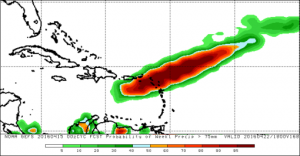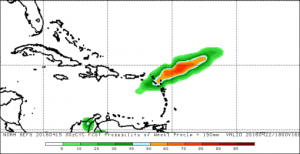Dale C. S. Destin |
A trough system could potentially cause drought-busting rainfall across Antigua and the rest of northeast Caribbean during this week. The system could dump up to 150 mm (6.0 in) of rain on the Leeward Islands and the Virgin Islands over the next six days, starting tonight – Sunday night.
We could get drought-busting rainfall i.e. sufficient rainfall to bring a welcome end to the meteorological and agricultural droughts taking place across Antigua and nearby islands. However, it is unclear as to whether it will be enough to replenish surface catchments and aquifers to end the more serious socioeconomic droughts, which are costing the islands dearly. Nevertheless, the rainfall is likely to put a big dent in this drought also.
Given the potential amount of rainfall that could occur, at least moderate flooding is possible of low-lying and flood-prone areas across the northeast Caribbean, including Antigua and Barbuda. Thus, the requisite watches and warnings may be required for portions of this week.


A number of weather models, including two of the best – the Integrated Forecast System (IFS) and the Global Forecasting System (GFS), are showing very high probabilities of this week being very wet, especially relative to April. However, it is not a 100% certain. Further, the eventual rainfall total is quite uncertain.
Most for the precipitation is likely to be in the form of rain from layer-type clouds as opposed to the showers from convective-type clouds. Notwithstanding, thunderstorms are possible every day from Monday to Friday. The sun could also be hidden by thick clouds for most of the week.
The normal rainfall for April is 85.6 mm (3.37 in). On record dating back to 1928, April 1981 is the wettest with 245.4 mm (9.66 in), and the driest is April 1944 with 5.8 mm (0.23 in). At the V. C. Bird International Airport, the normal rainfall for April 17-22 is 12.7 mm (0.50 in). The wettest was 1992 with 112.0 mm (4.41 in) and the driest of 0.0 mm occurred on at least six occasions since 1961.
Follow us and stay updated on this weather event via our social media platform, which includes twitter, facebook, wordpress, instagram, tumblr, and google+.
